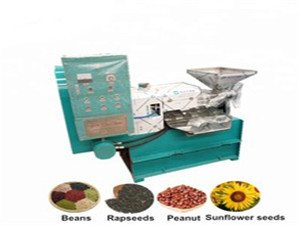
Pretreatment before oilseed pressing is a crucial step that determines the oil output rate of screw oil presses and the lifespan of the equipment. This article details the standardized operating points of the full - process from raw material cleaning, crushing, steaming, frying to conditioning. It also provides differential pretreatment parameter suggestions for common oilseeds such as rapeseeds, peanuts, and sunflower seeds.
The importance of raw material cleaning cannot be overstated. Impurities in oilseeds can not only affect the oil quality but also cause damage to the equipment. For example, stones and metal impurities can lead to wear and tear of the screw and other components in the oil press. By using appropriate cleaning methods such as screening and magnetic separation, we can effectively remove these impurities. According to industry experience, proper cleaning can reduce the wear and tear of the oil press by about 20% and improve the oil output rate by 1 - 2%.

The particle size after crushing has a significant impact on subsequent steaming, frying, and pressing processes. If the particles are too large, the heat transfer during steaming and frying will be uneven, resulting in incomplete oil extraction. On the other hand, if the particles are too small, it may cause problems such as clogging in the press chamber. Adjusting the crushing equipment to achieve the appropriate particle size is essential. For example, for peanuts, the ideal particle size is about 2 - 3 mm, which can increase the oil extraction efficiency by 3 - 4%.
In the steaming and frying stage, controlling the temperature and time is the key to ensuring oil quality. Different oilseeds have different optimal temperature and time requirements. For rapeseeds, the steaming and frying temperature is usually around 110 - 120°C, and the time is about 30 - 40 minutes. Proper temperature and time control can not only improve the oil output rate but also enhance the flavor and quality of the oil. Incorrect temperature and time settings, such as over - steaming and frying, can cause protein denaturation, reducing the oil output rate by about 5 - 8%.
Failure Lesson: A factory once over - steamed and fried peanuts, resulting in protein denaturation. As a result, the oil output rate dropped significantly, and the oil quality also deteriorated, causing a great loss to the enterprise.

In the conditioning stage, matching the moisture content with the temperature is the core strategy to achieve the best pressing state. For example, for cottonseeds, when the moisture content is controlled at about 8 - 10% and the temperature is around 90 - 100°C, the oil press can operate at its highest efficiency, increasing the oil output rate by 2 - 3%.
Each type of oilseed has its own characteristics, so different oilseeds require different pretreatment parameters. The following table shows the recommended parameters for some common oilseeds:
| Oilseed Type | Crushing Particle Size (mm) | Steaming and Frying Temperature (°C) | Steaming and Frying Time (min) | Conditioning Moisture (%) | Conditioning Temperature (°C) |
|---|---|---|---|---|---|
| Rapeseeds | 1 - 2 | 110 - 120 | 30 - 40 | 6 - 8 | 100 - 110 |
| Peanuts | 2 - 3 | 120 - 130 | 40 - 50 | 7 - 9 | 110 - 120 |
| Cottonseeds | 1 - 1.5 | 100 - 110 | 20 - 30 | 8 - 10 | 90 - 100 |

To help new employees quickly master the standard process, we provide a free Oilseed Pretreatment Operation Check List PDF template. In addition, we also recommend video demonstrations, which can make the learning process more intuitive. New employees can master the standard process in just 3 days with the help of these tools, reducing the waste rate by 3% and avoiding unnecessary equipment losses.
Are you ready to improve the efficiency of your oil pressing process? Click here to get more detailed information and start optimizing your oil pressing process now!

